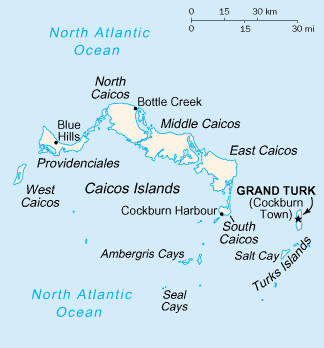Ambergris Cay


The Ambergris Cays are a group of small islands within the Turks and Caicos Islands. They are situated to the south of the main chain of the Caicos islands. The largest islands are Big Ambergris Cay and Small Ambergris Cay. It was named for valuable deposits of ambergris, a waxy substance that migrating sperm whales secrete, found on the 8 miles (13 km) of shoreline. The island is approximately four miles (6.4 kilometres) long, one mile (1.6 kilometres) wide, and 1,100 acres (4.5 km2) in total. It was uninhabited until 1997, but has a small population today. It has been privately owned since 1811.[1]
In the late 18th and early 19th centuries, Loyalists settled on Ambergris Cay, raised cows, made pottery, and built houses, stables, and cisterns (ruins still exist of each of these).
Harold Charles International Airport is located on the island it is the longest privately held airstrip in the Caribbean at 5,700 feet.[2]
The island has an exclusive private club called Turks & Caicos Sporting Club at Ambergris Cay, which received awards in 2009 from Caribbean World Magazine.[3] It hosts many outdoor pursuits including bonefishing flats; blue water and deep sea fishing and SCUBA diving with guides.[4]
History
John Lightbourne was the islands' first owner; he purchased it from the Bahamas administration in 1811.[5] Horatio Stubbs of South Caicos purchased the island, the dwelling house, and a female slave in 1826 for the cost of 6,000 bushels of salt.[6]
Sisal was raised on the island toward the end of the 1800s.[7]
In 1978 an investment group from the state of Arizona tried to purchase Ambergris Cay, with the goal of building a university on the island. This effort was rejected by the government.[8]
Ambergris Cay was bought by Canadian businessman Henry Mensen in 1995.[9]
Mensen started the development of the island to establish a luxury and exclusive residential community on his own. Later on, he brought in as partners other developers, DPS TCI Ltd., who in 2008 bought Mensen's shares to continue the project.
But in November 2008, 34 workers were dished pink slips following a slouch in sales said to have been caused from the collapse of the U.S. financial market.[10]
The project has been on hold since then.
On September 7th, 2017, the island took a direct hit from category 5 Hurricane Irma with sustained winds around 175 mph. [11]
Wildlife
The reefs are home to bonefish, jelly fish, conch and spiny lobster. Reports from local fishermen indicate that green and hawksbill sea turtles nest on the island.[12]
The island is home to the native Turks & Caicos Rock Iguana (Cyclura carinata) which is critically endangered. The San Diego Zoo has been working to capture, relocate, and the subsequent examination of homing abilities to assess the viability of relocation.[13]
Plant Species
Endemic to the Turks and Caicos Islands, Argythamnia argentea, Limonium bahamense and Encyclia caicensis are plant species found on Ambergris.[14]
Coordinates: 21°18′05.27″N 71°37′53.65″W / 21.3014639°N 71.6315694°W
References
- ↑ http://turksandcaicostourism.com/ambergris-cay.html
- ↑ http://turksandcaicostourism.com/ambergris-cay.html
- ↑ http://www.privateislandsonline.com/islands/ambergris-cay-property
- ↑ http://turksandcaicostourism.com/ambergris-cay.html
- ↑ http://www.turksandcaicos.tc/ambergriscay/
- ↑ http://www.turksandcaicos.tc/ambergriscay/
- ↑ http://www.turksandcaicos.tc/ambergriscay/
- ↑ http://www.turksandcaicos.tc/ambergriscay/
- ↑ http://suntci.com/ambergris-cay-development-could-restart-soon-p973-106.htm
- ↑ http://suntci.com/ambergris-cay-development-could-restart-soon-p973-106.htm#sthash.N1NT7d54.dpuf
- ↑ https://www.wunderground.com/cat6/triple-trouble-cat-5-irma-cat-3-jose-cat-1-katia
- ↑ http://www.turksandcaicos.tc/ambergriscay/
- ↑ http://blogs.sandiegozoo.org/2014/10/20/catching-rock-iguanas-cyclura-carinata/
- ↑ http://www.iccs.org.uk/wp-content/thesis/consci/2009/Williams.pdf